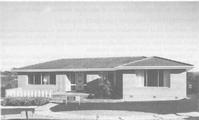


Chapter 6
I Construction During The Settlement Years
II The Use Of Timber As A Structural Material
III Structural Steel
IV Concrete Technology
V Housing
i First Settlement Technology
ii Development of the Industry
iii The Adoption of Solar Energy for Water Heating
iv Most Favourable Construction Productivity
v Housing in Cyclone Prone Localities
VI Industrialised Pre-cast Concrete Housing
VII Ports And Harbours
VIII Roads
IX Heavy Foundations
X Bridges
XI Sewerage
XII Water Engineering
XIII Railways
XIV Major Buildings
XV Airports
XVI Thermal Power Stations
XVII Materials Handling
XVIII Oil Industry
XIX The Snowy Mountains Scheme
XX The Sydney Opera House
XXI The Sydney Harbour Bridge
XXII Hamersley Iron
XXIII North West Shelf
Sources and References
Index
Search
Help
Contact us

Development of the Industry (continued)
One of the pioneers in the field of mass housing and particularly with the brick veneer home was the A. V. Jennings Group of Companies, located at Springvale, Melbourne. A typical Jennings cream brick veneer triple fronted Australian style house is illustrated in Fig. 15. Over recent years this Group, and other private commercial organisations and the CSIRO, undertook most effective research into all aspects of design and construction housing. This research effort has led to:-- Soils testing by professional engineers,
- Design and supervision of foundations and structures by professional engineers,
- Scientific testing of construction materials and building components,
- Quality control of brick manufacture,
- The development by Australian firms, particularly Monier Industries, of machine made high quality cement tiles,
- The development of colour bonded steel and aluminium sheet roofing panels,
- The development of plastic piping and plumbing fittings for water supply and
drainage, - The location of hot water heating and storage systems under eaves to conserve
space, - The prefabrication of windows and door frames with glass installed and doors
prehung off site, - The adoption of long life acrylic paints (10 years), which can be applied by rollers
and guns, - The adoption of scientifically planned attractive efficient and labour saving
kitchens.

Organisations in Australian Science at Work - A. V. Jennings Group; CSIRO; Monier Industries
People in Bright Sparcs - Rowell, L. E.
 |
Australian Academy of Technological Sciences and Engineering |  |
© 1988 Print Edition page 334, Online Edition 2000
Published by Australian Science and Technology Heritage Centre, using the Web Academic Resource Publisher
http://www.austehc.unimelb.edu.au/tia/333.html